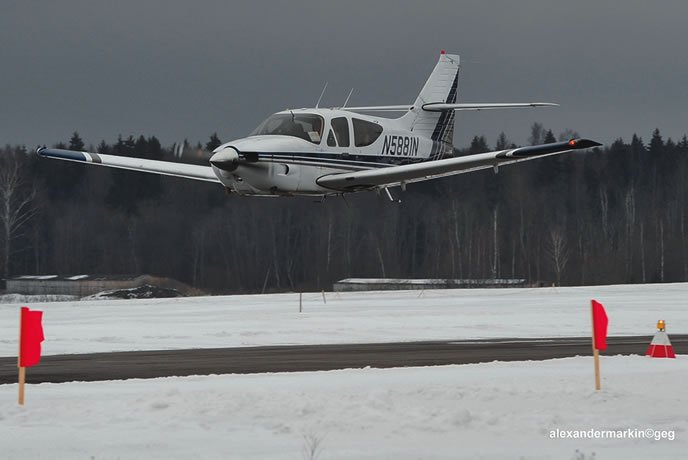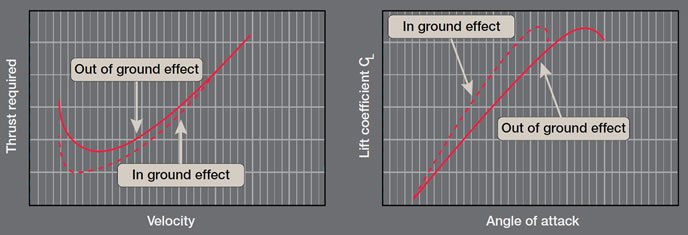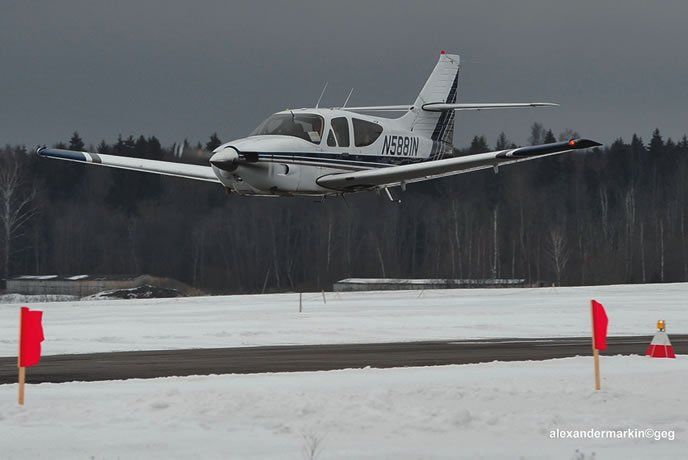The lack of respect many pilots give to ground effect sort of makes it the Rodney Dangerfield of aerodynamics. It’s that momentary sag right after takeoff, and that little bit of float on landing. We know about it, but it’s often an afterthought: “Oh, that’s how I screwed up that flare.” We all should know ground effect is only encountered…well, close to a flat surface, be it liquid or solid, but sometimes we forget.
Ground effect is a result of an airfoil’s so-called “downwash” changing velocity when a solid surface is close by. But how do we use it, and why? Any instructor worth his or her E-6B teaches students how to use ground effect on takeoff, especially from soft fields, so we all should know the basics. We can use it for other operations, too, and for other purposes.

How it works
When we move air past an airfoil, the lift generated also exerts a downward component as the air flows beyond the trailing edge. It’s commonly called downwash, but also involves the wing’s upwash and wingtip vortices. As a mass of air moves past a wing, its accelerated downward. Think of it as the lift’s “exhaust,” and we’re forcing it down.
There’s normally nothing to interfere with that downward-moving air. But when a flat surface, say, a runway, is beneath the wing, that downwash is deflected, and lift-induced drag is reduced. Parasite drag remains the same, but there’s an overall drag reduction as the amount of lift generated remains the same.
Since we all of a sudden have less overall drag, we also have better performance. We can use it to accelerate, since less thrust is required to maintain our existing lift/drag ratio. We also can use it to maintain altitude but fly more slowly or—is usually the case—employ some combination. Less induced drag for the same lift is a bargain, but it only exists close to the landing surface. How close is “close”? The closer, the better.
Perhaps the FAA’s Pilot’s Handbook of Aeronautical Knowledge, FAA-H-8083-25A, says it best: “When the wing is at a height equal to its span, the reduction in induced drag is only 1.4 percent. However, when the wing is at a height equal to one-fourth its span, the reduction in induced drag is 23.5 percent and, when the wing is at a height equal to one-tenth its span, the reduction in induced drag is 47.6 percent.”
What to do with it?
Obviously, we’ll get the most benefit from ground effect’s induced drag reduction by flying very close to the ground. For a typical personal airplane with a 40-foot wingspan, the wing must be four feet off the ground to see not even a 50-percent induced drag reduction. (I don’t know about you, but if whether I stayed aloft depended on keeping the wing within four feet of the ground, we’re not going to make it.) A better outcome with that same 40-foot wingspan might involve using the approximate 25-percent induced drag reduction available at 10 feet. Equally obvious, some airplane designs (low-wing) can achieve greater induced drag reductions from ground effect than others (high-wing).
Another thing should be obvious: Since the induced drag reduction is greater closer to the landing surface, as we climb away from a runway after takeoff, drag increases. This has implications for airplanes with marginal runway and takeoff performance, but also for the aforementioned soft-field takeoff, which we’ll get to in a moment.

A final thing to keep in mind is that what goes up must come down: The ways an airplane experiences ground effect when taking off and climbing away from the landing surface are inverted when descending to and landing on it. As the PHAK says, an airplane “…leaving ground effect will:
• Require an increase in AoA to maintain the same coefficient of lift (CL).
• Experience an increase in induced drag and thrust required.
• Experience a decrease in stability and a nose-up change in moment.
• Experience a reduction in static source pressure and increase in indicated airspeed.”
In other words, as we climb out of ground effect, the airplane experiences a decrease in performance, however slight, just when we don’t need it.
It gets better: All of these effects are reversed when landing. In other words, when we least want a reduced indicated airspeed, a nose-down moment, or a decrease in drag and thrust, that’s what we get. It’s no wonder primary students can have trouble with their landings.
The Soft-Field Takeoff
While detailed discussion of soft-field takeoffs is beyond this article’s scope, minimizing the surface-friction drag of an airplane’s landing gear is one of the maneuver’s objectives. Happily, we can eliminate that surface-friction drag if we can get the airplane off the soft field. Ground effect is good for that.
The basic technique is to get the airplane off the soft field at as low an airspeed as possible. This eliminates the surface-friction drag imposed by rolling tires on the ground, sliding skis on snow and ice, or pulling a set of floats through the water. (Hint: Adding enough aileron to pull one of the main-gear wheels, skis or floats up enough to minimize or eliminate its drag can help with a marginal takeoff.)
But we’re not done yet, and just because we’re airborne, sometimes only inches above the takeoff surface, it doesn’t mean we’re home free. We still need enough power to accelerate or climb, preferably both. But if we can get the airplane off the soft field, it’s likely to be easier finding acceleration than it will be altitude, at least initially. That’s why we’re trained to push the nose over to a more-or-less level attitude and accelerate the airplane to a speed at which we can establish a climb.
Other Uses
What about using ground effect during other flight operations? What about when landing? Doing so might be a bit more challenging than when taking off, but the effects of flying within a wingspan of the ground or water might come in handy, and not just when trying to return to base with battle damage, as many WWII bomber pilots based in England reportedly learned.
The classic example has the crew preparing to ditch in the English Channel but, as they descended close to the water, with three burning and one turning, the airplane stopped descending and the guys up front found they could maintain altitude on one engine. Eventually, they may have to clear the cliffs at Dover, but at least they could get to the right side of the Channel before ditching.
While we’ll go out on a limb and suggest you’ll never be over the Channel with battle damage, there could come a time when you have plenty of airspeed and unobstructed terrain—perhaps leading to a runway—but little or no power.
But the main way to use ground effect while landing is to minimize the speed at which we touch down. Since we can fly more slowly with the wing four feet above the runway than we can with it at 20 feet, remaining in ground effect as long as possible when attempting to land with, say, a landing gear failure or tire problem, will minimize stress on the airframe and allow touching down at the lowest groundspeed. That’s what happens when we “Hold it off—hold it off!” as our instructor coaches when first learning to land. (Later, we learn to plant it, risking dents in the runway, but that’s another article.)
Easy Does It
When it comes to actually using ground effect, be gentle. One of the keys to maximizing its impact on your operation is a fine touch on the controls. For example, when trying to accelerate off a soft field, we want to approach an effective zero angle of attack, thereby minimizing climb but maximizing acceleration. We do that by also maximizing our time spent in ground effect and enjoying reduced induced drag.
In other words, we want to lower the nose and reduce the airplane’s pitch attitude, managing the wing’s angle of attack to establish and maintain an altitude a few feet above the runway, while accelerating. Intentionally flying close to a landing surface in a level attitude may seem risky, especially since getting too close can have catastrophic consequences. But we do that all the time when landing and taking off.
Maximizing ground effect’s benefits in this manner require us to develop a light touch on the pitch control, and understand that, as the airplane accelerates in ground effect (or anywhere else, for that matter), control effectiveness will improve. Conversely, when decelerating, it deteriorates. The trick to mastering ground effect is to anticipate these changes and use a light touch.




